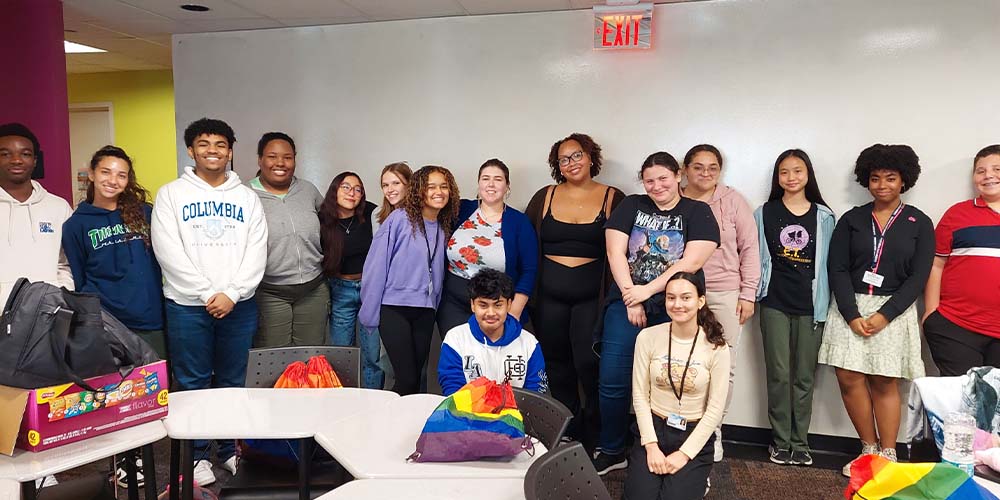Join or Start a GSA (Gender & Sexuality Alliance) Club at Your School
Welcome to the Safe Schools resource page for Gender & Sexuality Alliance (GSA) clubs! Whether you’re looking to join an existing GSA or start one at your school, you’ve come to the right place. GSAs are student-run organizations that provide a safe and supportive environment for LGBTQ+ students and allies to gather, discuss issues, and advocate for inclusivity and equality. Below, you’ll find everything you need to know about joining or starting a GSA at your school.
What is a GSA?
A Gender & Sexuality Alliance (GSA) is a student-led club that brings together LGBTQ+ youth and their allies to create a safe and welcoming space in schools. GSAs work to promote understanding, acceptance, and advocacy for LGBTQ+ issues and rights. These clubs often host events, discussions, and activities that educate and engage the school community in creating a more inclusive environment.
Benefits of Joining a GSA
Joining a Gender & Sexuality Alliance (GSA) offers numerous benefits for LGBTQ+ students and allies. GSAs provide a safe and supportive space for self-expression, fostering a sense of community and belonging. They empower students to advocate for inclusivity and equality, promoting positive change within their schools. Overall, joining a GSA helps build friendships and create positive change.
- Safe Space: GSAs provide a safe and supportive environment where students can be themselves without fear of judgment or discrimination.
- Community Building: GSAs foster a sense of community and belonging among LGBTQ+ students and allies.
- Advocacy: GSAs empower students to advocate for LGBTQ+ rights and promote inclusivity in their schools.
- Education: GSAs offer educational opportunities to learn about LGBTQ+ history, rights, and current issues.
How to Join an Existing GSA
If your school already has a GSA, joining is a simple process. Here’s how you can get involved:
- Find Out When and Where the GSA Meets: Check your school’s bulletin board, website, or ask a teacher for information about GSA meeting times and locations.
- Attend a Meeting: Drop by a GSA meeting to get a feel for the group and see if it’s the right fit for you. Meetings are usually open to all students, so don’t hesitate to attend.
- Introduce Yourself: Let the group know you’re interested in joining and share a little about yourself. GSAs are welcoming spaces where everyone is encouraged to be themselves.
- Get Involved: Participate in club activities, discussions, and events. Your involvement helps build a stronger community and promotes positive change.
How to Start a GSA at Your School
If your school doesn’t have a GSA yet, starting one is a great way to create a supportive space for LGBTQ+ students and allies. Here’s a step-by-step guide to help you get started:
Step 1: Research and Plan
- Understand the Purpose: Familiarize yourself with the goals and objectives of a GSA. This will help you articulate the club’s mission to others.
- Gather Information: Research your school’s policies on student clubs. Some schools may have specific requirements or procedures for starting new clubs.
- Talk to Other Students: Gauge interest among your peers. Talk to other students who might be interested in joining or supporting a GSA.
Step 2: Find a Faculty Advisor
- Choose an Ally: Identify a teacher, counselor, or staff member who is supportive of LGBTQ+ issues and willing to serve as the club’s advisor.
- Discuss the Role: Meet with your potential advisor to discuss the club’s goals and their responsibilities. A supportive advisor can be a great advocate and resource for your GSA.
Step 3: Draft a Mission Statement and Goals
- Mission Statement: Create a clear and concise mission statement that outlines the purpose of your GSA and what it hopes to achieve.
- Set Goals: Identify specific goals and activities for your club. Consider what issues you want to address and how you can make a positive impact at your school.
Step 4: Meet with School Administration
- Prepare Your Proposal: Gather all necessary documents, including your mission statement, goals, and a list of interested students.
- Schedule a Meeting: Request a meeting with school administrators to discuss your proposal. Be prepared to explain the importance of a GSA and how it will benefit the school community.
- Address Concerns: Be open to questions and concerns from administrators. Provide information and resources to address any misconceptions about GSAs.
Step 5: Promote Your GSA
- Spread the Word: Use posters, social media, and school announcements to promote your new GSA. Make sure students know when and where the first meeting will be held.
- Invite Allies: Encourage allies and supporters to join your GSA. The more diverse your group, the more inclusive and impactful it will be.
Step 6: Host Your First Meeting
- Welcome Attendees: Make everyone feel welcome and valued at your first meeting. Introduce the club’s mission and goals, and encourage open discussion.
- Plan Activities: Plan engaging activities that promote team building and understanding. Consider hosting a movie night, discussion panel, or guest speaker event.
- Establish Roles: Assign roles and responsibilities to club members. This can include positions like president, secretary, event coordinator, etc.
How to Start a GSA at Your School
If your school doesn’t have a GSA yet, starting one is a great way to create a supportive space for LGBTQ+ students and allies. Here’s a step-by-step guide to help you get started:
Step 1: Research and Plan
- Understand the Purpose: Familiarize yourself with the goals and objectives of a GSA. This will help you articulate the club’s mission to others.
- Gather Information: Research your school’s policies on student clubs. Some schools may have specific requirements or procedures for starting new clubs.
- Talk to Other Students: Gauge interest among your peers. Talk to other students who might be interested in joining or supporting a GSA.
Step 2: Find a Faculty Advisor
- Choose an Ally: Identify a teacher, counselor, or staff member who is supportive of LGBTQ+ issues and willing to serve as the club’s advisor.
- Discuss the Role: Meet with your potential advisor to discuss the club’s goals and their responsibilities. A supportive advisor can be a great advocate and resource for your GSA.
Step 3: Draft a Mission Statement and Goals
- Mission Statement: Create a clear and concise mission statement that outlines the purpose of your GSA and what it hopes to achieve.
- Set Goals: Identify specific goals and activities for your club. Consider what issues you want to address and how you can make a positive impact at your school.
Step 4: Meet with School Administration
- Prepare Your Proposal: Gather all necessary documents, including your mission statement, goals, and a list of interested students.
- Schedule a Meeting: Request a meeting with school administrators to discuss your proposal. Be prepared to explain the importance of a GSA and how it will benefit the school community.
- Address Concerns: Be open to questions and concerns from administrators. Provide information and resources to address any misconceptions about GSAs.
Step 5: Promote Your GSA
- Spread the Word: Use posters, social media, and school announcements to promote your new GSA. Make sure students know when and where the first meeting will be held.
- Invite Allies: Encourage allies and supporters to join your GSA. The more diverse your group, the more inclusive and impactful it will be.
Step 6: Host Your First Meeting
- Welcome Attendees: Make everyone feel welcome and valued at your first meeting. Introduce the club’s mission and goals, and encourage open discussion.
- Plan Activities: Plan engaging activities that promote team building and understanding. Consider hosting a movie night, discussion panel, or guest speaker event.
- Establish Roles: Assign roles and responsibilities to club members. This can include positions like president, secretary, event coordinator, etc.
Frequently Asked Questions
1. Do I need permission from my parents to join a GSA?
- While parental permission is not usually required to join a GSA, it’s important to know your school’s policies. If you have concerns about privacy, discuss them with your GSA advisor or a trusted teacher. (As of 2024, the law in Florida regarding permission slips is still in flux. Please contact us with any individual questions you might have about permission slips, and we will be happy to assist you.)
2. What if my school denies my request to start a GSA?
- If your school denies your request to start a GSA, contact us, or organizations like the ACLU or GLSEN for guidance. Schools receiving federal funding are required to treat all student clubs equally under the Equal Access Act.
3. How can I make my GSA more inclusive?
- Encourage diverse participation by welcoming all students, regardless of their identity. Plan activities that promote understanding and celebrate the diversity of the LGBTQ+ community.
4. What if I experience bullying or harassment?
- If you experience bullying or harassment, report it to a trusted teacher, counselor, or school administrator. GSAs are safe spaces, and it’s important to stand up against discrimination.
Resources for GSAs
Here are some valuable resources to support your GSA journey:
- GLSEN GSA Resources: A comprehensive guide for starting and running a successful GSA.
- GSA Network: Provides resources and support for GSAs across the country.
- ACLU LGBTQ+ Rights: Information on legal rights for LGBTQ+ students.
- Equality Florida: Offers resources and support for LGBTQ+ students in Florida.
- Safe Schools Student Resources: Additional resources and support for students.
Connect with Us
Safe Schools is here to support you every step of the way. If you have questions or need additional resources, please contact us at info@safeschoolssouthflorida.org or call us at 305.582.0710.
By providing a welcoming and inclusive space, GSAs can make a significant difference in the lives of LGBTQ+ students and their allies. Whether you’re joining an existing GSA or starting one from scratch, your efforts are vital to creating a more understanding and accepting school environment. We’re excited to see the positive change you can bring to your school!







